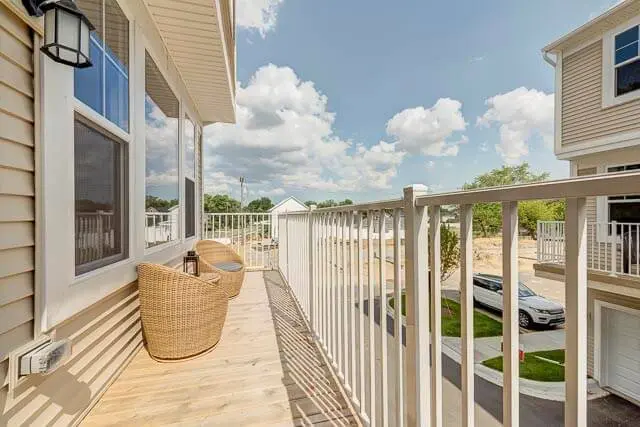
There’s a lot of talk these days about smart home products — smart thermostats, light switches and doorbells. The buzz has overshadowed advances in basic building materials. When it comes to building a custom home, windows may represent a bigger opportunity for cost-savings than highly publicized gadgets.
Fenestration — the arrangement and design of windows and doors in your house — is often the weak link in a home’s energy armor, especially in older homes where a single pane of glass may be all that separates an air-conditioned home from blazing summer heat. On an existing home, replacing single-pane windows with energy-efficient ones can easily save $500 a year in utility bills.
The potential for energy savings may not be as great on new homes, since the default standard would be double-paned windows with a low-e coating (an almost invisible coating of metal that slows the heat transfer of the glass). But technological advances present an intriguing an opportunity to fine-tune the heat loss, solar gain and transparency of windows on a custom home depending on your climate and the window’s solar orientation. This is often done on so-called net zero homes that produce all the energy they need to consume.
The big payoff, besides energy savings, is getting more comfortable, usable rooms. It’s possible to optimize the solar gain and light transfer of north-facing windows that don’t get a lot of sunlight. At the same time, you could minimize the solar gain of west-facing windows that get pounded by harsh afternoon sun and tax your air conditioning. If you are building a home in the mountains, where temperatures throughout the year can fluctuate from zero to 90 degrees, you could upgrade to windows that help keep the home at a steady temperature year-round.
An Easy Tech Primer
When evaluating windows, first look at the U-value, which measures the rate of heat flow through windows as a result of the difference between indoor and outdoor temperatures. The lower the U-value, the better the resistance to heat loss. So, it’s not surprising that U-value matters more on houses built in the North than in the South. The typical double-pained low-e window may yield a U-value at or below 0.30, which outperforms the U.S. Department of Energy’s recommendation that you use windows with a U-value of at least 0.40.
These days, it’s possible to do much better than even 0.30. Most major manufacturers offer a premium line with a third pane of glass and argon or krypton gas separating them that may get to 0.15. The heavy gas blocks air exchange between inside and outside. When comparing the U-value of windows, look for a measure that considers the entire unit. Some manufacturers may quote U-values for the glass or frame alone.
Frame and sash construction can also influence energy performance. Manufacturers often add multiple air chambers to improve the thermal resistance of vinyl windows. Metal cladding, added to protect windows on the outside, can form a thermal bridge around lesser conducting wood frames. Installing spacers between the glazing and frame material lowers the U-value. Even the type of gas used between glass layers can have an influence. “In the north, you always want a low U-value,” says Chicago architect Nathan Kipnis. “The better the insulation for the windows, the better for the house.”
U-value isn’t as big a concern in the South, says Austin-based architect Peter Pfeiffer, who designs custom homes throughout the country. “The U-value is more a function of when you’ve got a big temperature difference between the inside and outside air,” he says. “In Austin, in our peak conditions of 100 degrees outside and 75 degrees inside, it’s a 25-degree what we call delta T. It doesn’t really matter that much what the resistance to heat flow value is. In northern climates, where it’s 70 degrees inside and 0 degrees outside — that’s a 70-degree differential — resistance comes in.”
Let Sunshine In?
Pfeiffer does pay close attention to windows’ solar heat gain coefficient (SHGC). This measure tells you how much of the sun’s energy striking the window is transmitted through the window as heat. The higher the SHGC, the more potential solar gain. A rating of 1 means that all of the incident solar energy is transmitted through the window. A rating of 0 means that none gets through. A window with a SHGC of 0.6 will admit twice as much solar heat as one with a SHGC of 0.3.
In northern climates, where you can use all the heat from the sun you can get in the winter, you may want to use windows with a high SHGC, so that they transmit as much heat as possible. The trick is to use awnings or overhangs to shade the windows in the summer, which is easier to do when the sun is high in the sky. The other thing you could do is vary the SHGC of windows around the house, depending on their solar orientation and whether shading is a possibility.
“The easy way to think of this is that the low sun from the East and West are the worst — they are very difficult to control,” Kipnis says. “Shading really doesn’t work at all for those orientations. So, you’d want a low SHGC for east and west windows to control the solar gain. On the south side, though, where you can use solar gain to warm the house, if that is how the house is designed, then you want a high SHGC. On north-facing windows, I would say this isn’t a significant issue.”
One concern is that the glass with higher SHGCs may appear darker, says Nick Pesl, a technical specialist with Kolbe & Kolbe, which increasingly fields orders from architects who seek to vary coefficients. “You can notice quite a difference,” he says. “If you are going to use different glass around the house, try to use the same glass on the same façade. You don’t want two different types of glass in the kitchen, for instance. That wouldn’t work well in the long run.”
Planning for Shade
Varying the SHGC by solar orientation is a good strategy on homes in the South as well, says Pfeiffer. “We would want to have a much greater solar heat gain coefficient — one that lets in less heat and light — on an east- and west-facing window and one that allows in more light on a north- and south-facing window. But I’ve learned that that can get kind of confusing for the guys out in the field.”
To save money, and reduce confusion, Pfeiffer specifies clear, old-fashioned double-paned windows between the house and a screened porch, presuming those windows are in the shade. The windows may not even have a low-e coating. He wants those windows to emit as much daylight as possible. That way they light interior spaces so that owners don’t have to turn on electric lights to read.
Another big issue is making sure the awning or overhang over south-facing windows is the right size. The ideal can vary by region depending on the angle of the sun. Most architects use computer modeling software or spreadsheets to optimize overhangs and window specifications. “Shading the window in the summertime trumps any and all of this other stuff,” Pfeiffer says. “Then what we do is low-e glazing here in the South for all the windows that might be exposed to the sun.”
Visible Light Transmittance
Another important technical variable in windows and patio doors is how much visible light they transfer, or visible light transmittance (VLT). The lower the VLT, the darker the window tint and the more light that gets blocked. You might want a low VLT on a window that could create glare in a room, like a white kitchen with stainless steel appliances. On the other hand, you may want all the visible light you can get for a window shaded by overhangs or for a skylight used to brighten a dark corridor of the house.
Low-e coatings don’t necessarily impact how much visible light get through. Their goal is to minimize the amount of ultraviolet and infrared light that pass through without compromising how much visible light is transmitted. The benefit of low-e coatings is that they block the sun’s oppressive heat during the summer and reflects heat back into the room in the winter. That said, most double-paned low-e windows carry a VLT between 0.30 and 0.70.
Managing UV Levels
For some people building a custom home, blocking ultraviolet light may be critical as it can fade curtains, furnishings and even works of art. Kolbe’s 366 line allows only 5 percent UV transmittance, says Pesl. “But the very best is laminated glass — that blocks 99 percent. That’s two pieces of glass with a polyvinyl laminate in the middle. It looks just as clear as glass. You can also get better sound ratings, and it can deter vandalism.”
There’s also an opportunity to add tints and colorings to windows, but most of that business is done with existing homes. As a practical matter, if you get the other variables right, there’s no need to do this on a custom home. The tactic may even backfire, says Pesl. “Heat can build up between the film and glass.”
Air leakage is another technical variable to consider. Not all windows are rated for air leakage. The Department of Energy’s Energy Star program includes a maximum air leakage threshold of no more than 0.3 cubic feet per minute. The lower the measurement, the less air will pass through. Some people think the small amount of air leakage through windows today provides an acceptable amount of ventilation. But if you are building a passive house (highly energy efficient), or one that would be subject to strong gusts of cold air, you want to pay extra attention to air leakage. In these cases, energy losses must be kept to an absolute minimum.
Windows have gone from major liability — consider the typical home may have 15 or more windows that can leak energy — to major weapon in the hands of a skilled custom home architect. They aren’t just sturdier and more energy-efficient. They can be fine-tuned to manipulate light and energy in ways never before possible. They can produce homes with much more livable interior spaces and very low energy bills. It’s a brave new world when it comes to selecting windows.

Boyce Thompson is the author of three books on residential design and construction. His first book, The New New Home, published by The Taunton Press, was named book of the year by the National Association of Real Estate Editors. Anatomy of a Great Home (Schiffer Publishing 2018) features the work of three dozen of the country’s leading architects. The book identifies the common elements of great residential architecture, breaking them down into terms anyone can appreciate. Designing for Disaster, to be published by Schiffer in 2019, identifies best practices for resilient home design.
In 2008, Thompson was given the Crain Award by American Business Media for lifetime achievement in business media. In 2010, he was inducted into the Editorial Hall of Fame by min magazine, a magazine for publication professionals. Thompson holds a BA in English from Northwestern University and a master’s degree in journalism from the University of Missouri. He lives in Bethesda, Maryland.
 Do You Have to Be Rich to Build a Custom Home?
Do You Have to Be Rich to Build a Custom Home?